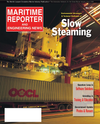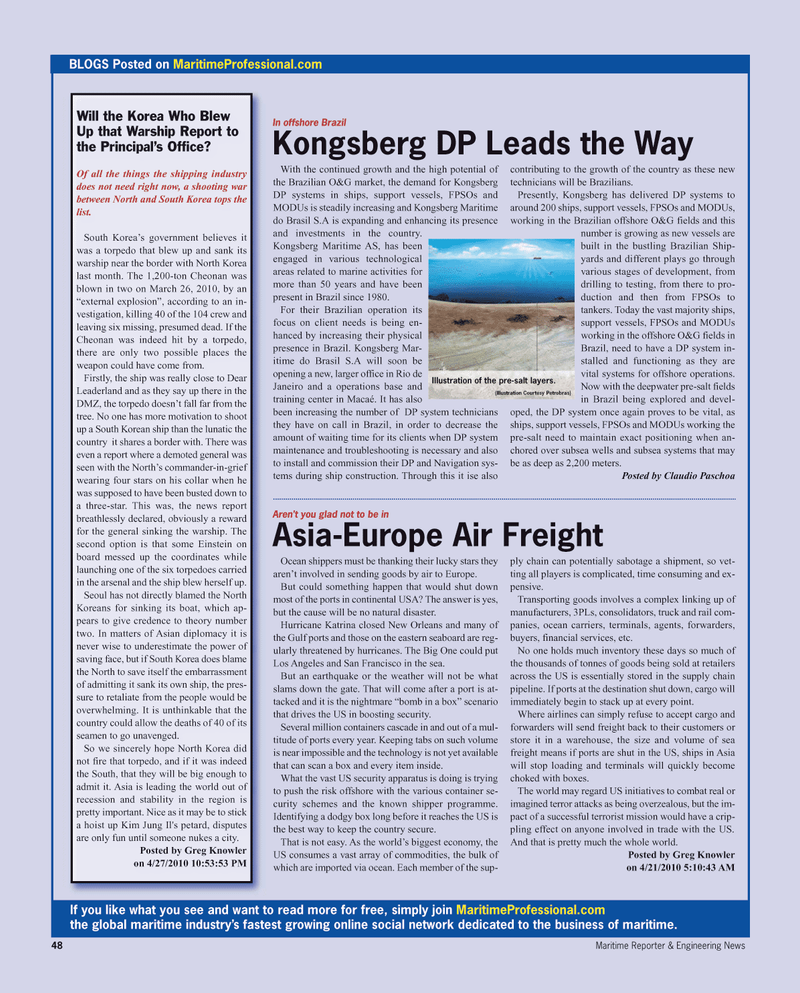
Page 48: of Maritime Reporter Magazine (May 2, 2010)
Read this page in Pdf, Flash or Html5 edition of May 2, 2010 Maritime Reporter Magazine
48 Maritime Reporter & Engineering News
Ocean shippers must be thanking their lucky stars they aren’t involved in sending goods by air to Europe.
But could something happen that would shut down most of the ports in continental USA? The answer is yes, but the cause will be no natural disaster.
Hurricane Katrina closed New Orleans and many of the Gulf ports and those on the eastern seaboard are reg- ularly threatened by hurricanes. The Big One could put
Los Angeles and San Francisco in the sea.
But an earthquake or the weather will not be what slams down the gate. That will come after a port is at- tacked and it is the nightmare “bomb in a box” scenario that drives the US in boosting security.
Several million containers cascade in and out of a mul- titude of ports every year. Keeping tabs on such volume is near impossible and the technology is not yet available that can scan a box and every item inside.
What the vast US security apparatus is doing is trying to push the risk offshore with the various container se- curity schemes and the known shipper programme.
Identifying a dodgy box long before it reaches the US is the best way to keep the country secure.
That is not easy. As the world’s biggest economy, the
US consumes a vast array of commodities, the bulk of which are imported via ocean. Each member of the sup- ply chain can potentially sabotage a shipment, so vet- ting all players is complicated, time consuming and ex- pensive.
Transporting goods involves a complex linking up of manufacturers, 3PLs, consolidators, truck and rail com- panies, ocean carriers, terminals, agents, forwarders, buyers, financial services, etc.
No one holds much inventory these days so much of the thousands of tonnes of goods being sold at retailers across the US is essentially stored in the supply chain pipeline. If ports at the destination shut down, cargo will immediately begin to stack up at every point.
Where airlines can simply refuse to accept cargo and forwarders will send freight back to their customers or store it in a warehouse, the size and volume of sea freight means if ports are shut in the US, ships in Asia will stop loading and terminals will quickly become choked with boxes.
The world may regard US initiatives to combat real or imagined terror attacks as being overzealous, but the im- pact of a successful terrorist mission would have a crip- pling effect on anyone involved in trade with the US.
And that is pretty much the whole world.
Posted by Greg Knowler on 4/21/2010 5:10:43 AM
With the continued growth and the high potential of the Brazilian O&G market, the demand for Kongsberg
DP systems in ships, support vessels, FPSOs and
MODUs is steadily increasing and Kongsberg Maritime do Brasil S.A is expanding and enhancing its presence and investments in the country.
Kongsberg Maritime AS, has been engaged in various technological areas related to marine activities for more than 50 years and have been present in Brazil since 1980.
For their Brazilian operation its focus on client needs is being en- hanced by increasing their physical presence in Brazil. Kongsberg Mar- itime do Brasil S.A will soon be opening a new, larger office in Rio de
Janeiro and a operations base and training center in Macaé. It has also been increasing the number of DP system technicians they have on call in Brazil, in order to decrease the amount of waiting time for its clients when DP system maintenance and troubleshooting is necessary and also to install and commission their DP and Navigation sys- tems during ship construction. Through this it ise also contributing to the growth of the country as these new technicians will be Brazilians.
Presently, Kongsberg has delivered DP systems to around 200 ships, support vessels, FPSOs and MODUs, working in the Brazilian offshore O&G fields and this number is growing as new vessels are built in the bustling Brazilian Ship- yards and different plays go through various stages of development, from drilling to testing, from there to pro- duction and then from FPSOs to tankers. Today the vast majority ships, support vessels, FPSOs and MODUs working in the offshore O&G fields in
Brazil, need to have a DP system in- stalled and functioning as they are vital systems for offshore operations.
Now with the deepwater pre-salt fields in Brazil being explored and devel- oped, the DP system once again proves to be vital, as ships, support vessels, FPSOs and MODUs working the pre-salt need to maintain exact positioning when an- chored over subsea wells and subsea systems that may be as deep as 2,200 meters.
Posted by Claudio Paschoa
In offshore Brazil
Kongsberg DP Leads the Way
If you like what you see and want to read more for free, simply join MaritimeProfessional.com the global maritime industry’s fastest growing online social network dedicated to the business of maritime.
BLOGS Posted on MaritimeProfessional.com
Will the Korea Who Blew
Up that Warship Report to the Principal’s Office?
Of all the things the shipping industry does not need right now, a shooting war between North and South Korea tops the list.
South Korea’s government believes it was a torpedo that blew up and sank its warship near the border with North Korea last month. The 1,200-ton Cheonan was blown in two on March 26, 2010, by an “external explosion”, according to an in- vestigation, killing 40 of the 104 crew and leaving six missing, presumed dead. If the
Cheonan was indeed hit by a torpedo, there are only two possible places the weapon could have come from.
Firstly, the ship was really close to Dear
Leaderland and as they say up there in the
DMZ, the torpedo doesn’t fall far from the tree. No one has more motivation to shoot up a South Korean ship than the lunatic the country it shares a border with. There was even a report where a demoted general was seen with the North’s commander-in-grief wearing four stars on his collar when he was supposed to have been busted down to a three-star. This was, the news report breathlessly declared, obviously a reward for the general sinking the warship. The second option is that some Einstein on board messed up the coordinates while launching one of the six torpedoes carried in the arsenal and the ship blew herself up.
Seoul has not directly blamed the North
Koreans for sinking its boat, which ap- pears to give credence to theory number two. In matters of Asian diplomacy it is never wise to underestimate the power of saving face, but if South Korea does blame the North to save itself the embarrassment of admitting it sank its own ship, the pres- sure to retaliate from the people would be overwhelming. It is unthinkable that the country could allow the deaths of 40 of its seamen to go unavenged.
So we sincerely hope North Korea did not fire that torpedo, and if it was indeed the South, that they will be big enough to admit it. Asia is leading the world out of recession and stability in the region is pretty important. Nice as it may be to stick a hoist up Kim Jung Il's petard, disputes are only fun until someone nukes a city.
Posted by Greg Knowler on 4/27/2010 10:53:53 PM
Illustration of the pre-salt layers. (Illustration Courtesy Petrobras)
Aren’t you glad not to be in
Asia-Europe Air Freight

 47
47

 49
49
